The magic of wide-format digital printing transforms space and public perceptions, turning fabric into gold.
As we’ve seen in “If walls could talk,” décor is one of the most popular applications for digitally printed fabric graphics today, and will likely be one of the fastest-growing markets in the future. But what is it, specifically, about the use of graphics in interiors that makes it so compelling right now? And how can we expand our understanding of fabric graphics in that context to its use in other markets, such as banners, vehicle wraps, tents, point-of-sale displays, trade show booths, billboards and building wraps? In other words, what’s the underlying theme?
Maureen Kelly, president of The Design Loft Co./The Flag Loft, St. Louis, Mo., realized what that theme was last November when her company was working on a fabric ceiling system at the Hotel Indigo, Atlanta, Ga. Another firm was there installing a reproduction of a painting, writ large: the final piece spanned about 20 by 20 feet, completely changing the dynamics of the room.
“I especially like to work in spaces where the textiles can change the spaces we inhabit,” she says. “In this case, there was the softness of a fabric ceiling in combination with the digitally printed canvas painting that changed the perception of space.”
That’s the essence of it: with their seamlessness, depth, and sometimes startling reproduction of real-life imagery, digitally printed textiles have the ability to alter our fundamental understanding of the space we inhabit. The principle is more obvious in décor applications, where the space is often confined, but it’s in play everywhere. A successful trompe l’oeil building wrap is a good example. It doesn’t really fool us; it catches our interest because it’s clever and impressive.
The understanding—that by installing digitally printed large-format pieces, end-product manufacturers are tweaking people’s perception of the environment—should inform the design process from the start, no matter where the piece will be installed or what type of structure it will adorn.
It should also inform discussions with clients. When retail establishments commission digitally printed point-of-purchase displays, or when corporate clients commission printed trade show booths and event tents, it is this transformative quality that they are seeking. Otherwise, they would have sought out a different type of product.
Practical matters
Where should fabricators focus their energies right now? “The fastest-growing segments in the U.S. market are outdoor banners and signs, décor, and trade show graphics,” says Bill Shuford, product manager at Beaver Paper & Graphic Media Inc., Lawrenceville, Ga. But looking forward, he says, the newest fabric graphic market segments with significant forecasted growth include awnings and canopies and the use of indoor graphics.
The implication is that digital printing experts may want to team up with companies whose core competency is awnings and canopies, and that awning companies need to school themselves in digital printing if they haven’t already.
That’s the 5000-foot view. On the ground level, several trends are at play in 2016, most of which have to do with the mechanics of the digital printing process.
Jamie Swedberg is a freelance writer based in Woodville, Ga.
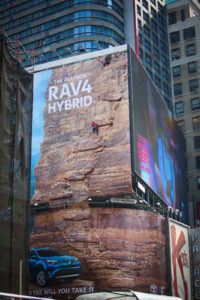
Billboard goes over the top with a built-in climbing wall
“Buildering” is what daring climbers do, scaling urban structures—with or without safety ropes—and they usually end up getting arrested. But it also usually generates lots of publicity. Toyota Motor Sales U.S.A. and their ad agency Saatchi & Saatchi took notice when coming up with a new outdoor ad campaign to introduce the RAV4 Hybrid this spring. The result was a 10-story, climbable billboard in New York’s Times Square—with professional climbers actually scaling the billboard’s face during the New York International Auto Show. It certainly had the kind of impact Toyota sought. Social media was buzzing with activity about the launch, fueled by thousands of people watching the climbers. “How far will you take it?” is the campaign’s slogan.
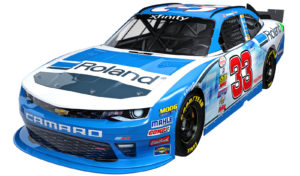
Wrapping up the NASCAR season—in advance
The Richard Childress Racing (RCR) graphics team prints and installs new race car wraps prior to every race in the NASCAR 2016 season. It also wraps RCR’s back-up cars, eight haulers, 15 “show-car” trailers, tool boxes and pit boxes. The season began February 13, but the graphics team started picking up speed in July 2015 at the RCR Graphics Center facility in Welcome, N.C. “For the most part, we’re pumping out prints all day long, all the way up to the racing season,” says Nick Woodward, graphics manager. Over the course of a year, Woodward estimates that RCR Graphics Center will print more than 120,000 square feet of vinyl. The wide-format digital printers and printer/cutters from Roland DGA Corporation, Irvine, Calif., keep the wheels of RCR graphics turning.
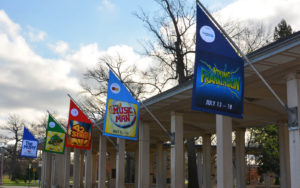
A banner year, every year
The MUNY (The Municipal Theatre Association of St. Louis), located in Forest Park, St. Louis, Mo., is the largest outdoor musical amphitheater in the United States, seating 11,000 people. It is currently celebrating its 98th season. The Design Loft, also based in St. Louis, has been manufacturing banners for the MUNY’s entrance for 26 years. Five years ago, designer Maureen Kelly changed the banners from sewn appliqué to digitally printed nylon. “What a difference!” she says. “Since these need to last eight months, the digitally printed nylon was a perfect choice, because the colors pop so well and we get the detail that was missing from the appliqué.” These banners were printed on The Design Loft’s two 1800 Mimaki printers, using acid-dye inks on optic white 200-denier nylon.
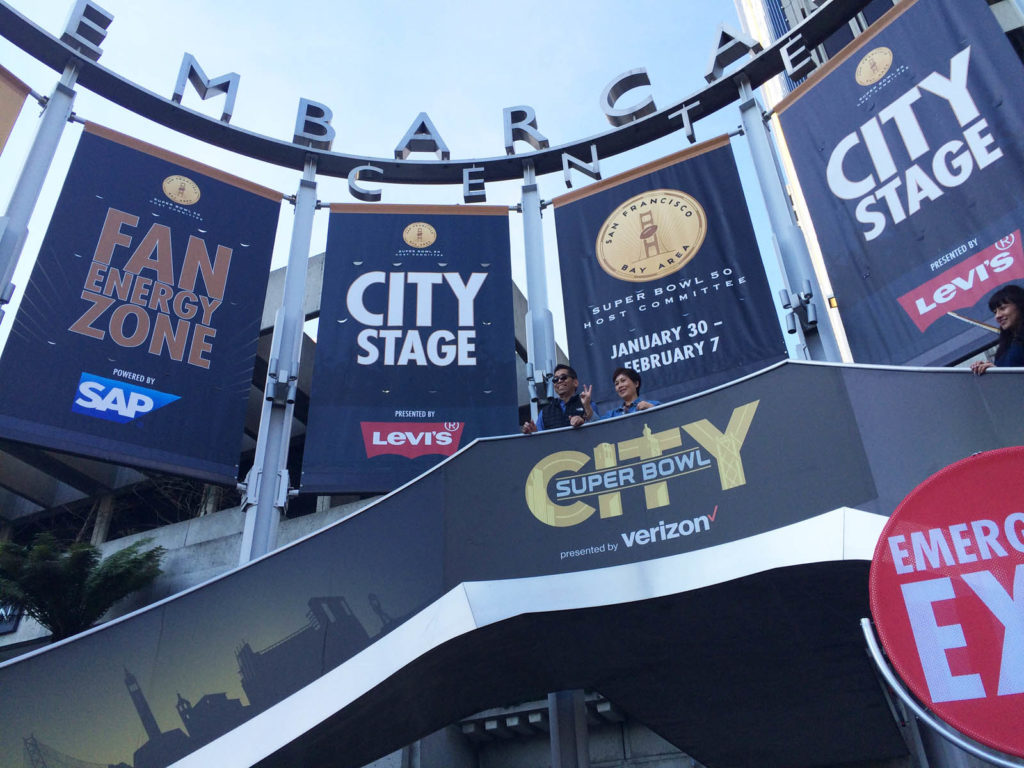
Super Bowl 50’s dramatic fan village
Super Bowl City presented by Verizon was the Super Bowl 50 Host Committee’s free-to-the-public fan village designed to celebrate the milestone Super Bowl 50 and to highlight its unique place in the San Francisco Bay Area. The area was open January 30–February 7, 2016, and featured ample opportunities for fans to take photos in front of spectacular signage and banners to remember the big event.
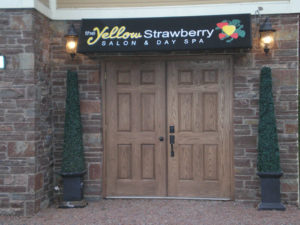
Salon signage turns heads
The Yellow Strawberry Salon & Day Spa in Waverley, Nova Scotia, Canada, needed signage and building aesthetics for a new location. Its logo was demanding and intricate, and the occasion demanded an eye-catching design. Halifax’s Creative Textile Solutions Ltd. came through with this awning, screen-printed on Glen Raven Sunbrella® with Nazdar inks. The shop used multiple registrations to pull off the look and finished it off with hand-applied ink.
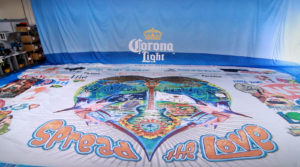
Sew What? Inc. “spreads the love” with Kenny Chesney
Sew What? Inc., Rancho Dominguez, Calif., has produced a unique opening show drape for Kenny Chesney’s 2016 “Spread the Love” tour. The country superstar’s show features drapery and surrounds designed and branded for this tour and part of a concept executed across all mediums: album art, merchandise, festival set and stage designs. The custom stage drape was 43 feet high by almost 75 feet wide; wide-format, digital printing presents picture perfect images on textiles useful for nearly all venues. Seamless images up to 16 feet wide can be produced on a variety of indoor and outdoor fabrics. A polyester poplin substrate was used for great color reactivity and durability—and it’s “hamper friendly” and tour ready. Megan Duckett, owner of Sew What? Inc. and sister company, Rent What? Inc., says, “We built all the elements with longevity in mind and to keep performing, no matter how grueling the show schedule is.”
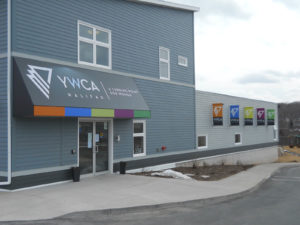
Bright signage greets YWCA members
A new building calls for a big splash, and that’s what Halifax’s Creative Textile Solutions Ltd. (CTS) set out to do with the signage and building aesthetics for the Halifax YWCA. The banners are made of BannerBrite 18-ounce substrate, two layers back to back, printed with UV-cured inks on a wide-format flatbed printer. The awning is Cooley Brite fabric substrate with an over-laminate, printed with the same equipment and inks. “The banners and awning tie the building concept together,” says CTS president Paul Aumento. “It gives them great location identification, together with the awning providing protection for customers when they are entering.”
 TEXTILES.ORG
TEXTILES.ORG


